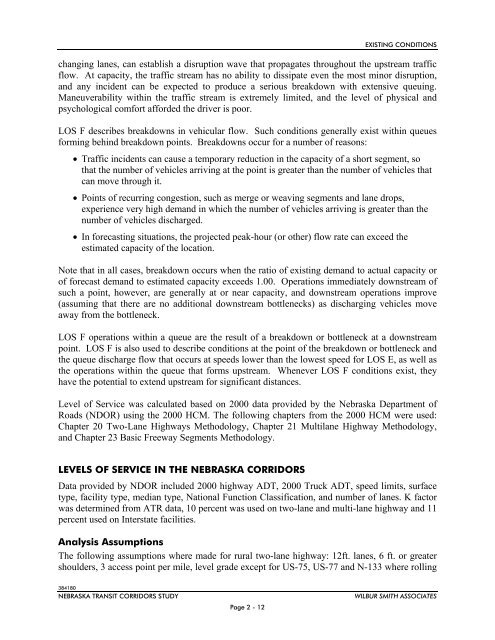NTRAC Final Study - Nebraska Department of Roads - State of ...
NTRAC Final Study - Nebraska Department of Roads - State of ...
NTRAC Final Study - Nebraska Department of Roads - State of ...
You also want an ePaper? Increase the reach of your titles
YUMPU automatically turns print PDFs into web optimized ePapers that Google loves.
EXISTING CONDITIONS<br />
changing lanes, can establish a disruption wave that propagates throughout the upstream traffic<br />
flow. At capacity, the traffic stream has no ability to dissipate even the most minor disruption,<br />
and any incident can be expected to produce a serious breakdown with extensive queuing.<br />
Maneuverability within the traffic stream is extremely limited, and the level <strong>of</strong> physical and<br />
psychological comfort afforded the driver is poor.<br />
LOS F describes breakdowns in vehicular flow. Such conditions generally exist within queues<br />
forming behind breakdown points. Breakdowns occur for a number <strong>of</strong> reasons:<br />
Traffic incidents can cause a temporary reduction in the capacity <strong>of</strong> a short segment, so<br />
that the number <strong>of</strong> vehicles arriving at the point is greater than the number <strong>of</strong> vehicles that<br />
can move through it.<br />
Points <strong>of</strong> recurring congestion, such as merge or weaving segments and lane drops,<br />
experience very high demand in which the number <strong>of</strong> vehicles arriving is greater than the<br />
number <strong>of</strong> vehicles discharged.<br />
In forecasting situations, the projected peak-hour (or other) flow rate can exceed the<br />
estimated capacity <strong>of</strong> the location.<br />
Note that in all cases, breakdown occurs when the ratio <strong>of</strong> existing demand to actual capacity or<br />
<strong>of</strong> forecast demand to estimated capacity exceeds 1.00. Operations immediately downstream <strong>of</strong><br />
such a point, however, are generally at or near capacity, and downstream operations improve<br />
(assuming that there are no additional downstream bottlenecks) as discharging vehicles move<br />
away from the bottleneck.<br />
LOS F operations within a queue are the result <strong>of</strong> a breakdown or bottleneck at a downstream<br />
point. LOS F is also used to describe conditions at the point <strong>of</strong> the breakdown or bottleneck and<br />
the queue discharge flow that occurs at speeds lower than the lowest speed for LOS E, as well as<br />
the operations within the queue that forms upstream. Whenever LOS F conditions exist, they<br />
have the potential to extend upstream for significant distances.<br />
Level <strong>of</strong> Service was calculated based on 2000 data provided by the <strong>Nebraska</strong> <strong>Department</strong> <strong>of</strong><br />
<strong>Roads</strong> (NDOR) using the 2000 HCM. The following chapters from the 2000 HCM were used:<br />
Chapter 20 Two-Lane Highways Methodology, Chapter 21 Multilane Highway Methodology,<br />
and Chapter 23 Basic Freeway Segments Methodology.<br />
LEVELS OF SERVICE IN THE NEBRASKA CORRIDORS<br />
Data provided by NDOR included 2000 highway ADT, 2000 Truck ADT, speed limits, surface<br />
type, facility type, median type, National Function Classification, and number <strong>of</strong> lanes. K factor<br />
was determined from ATR data, 10 percent was used on two-lane and multi-lane highway and 11<br />
percent used on Interstate facilities.<br />
Analysis Assumptions<br />
The following assumptions where made for rural two-lane highway: 12ft. lanes, 6 ft. or greater<br />
shoulders, 3 access point per mile, level grade except for US-75, US-77 and N-133 where rolling<br />
384180<br />
NEBRASKA TRANSIT CORRIDORS STUDY<br />
Page 2 - 12<br />
WILBUR SMITH ASSOCIATES

















